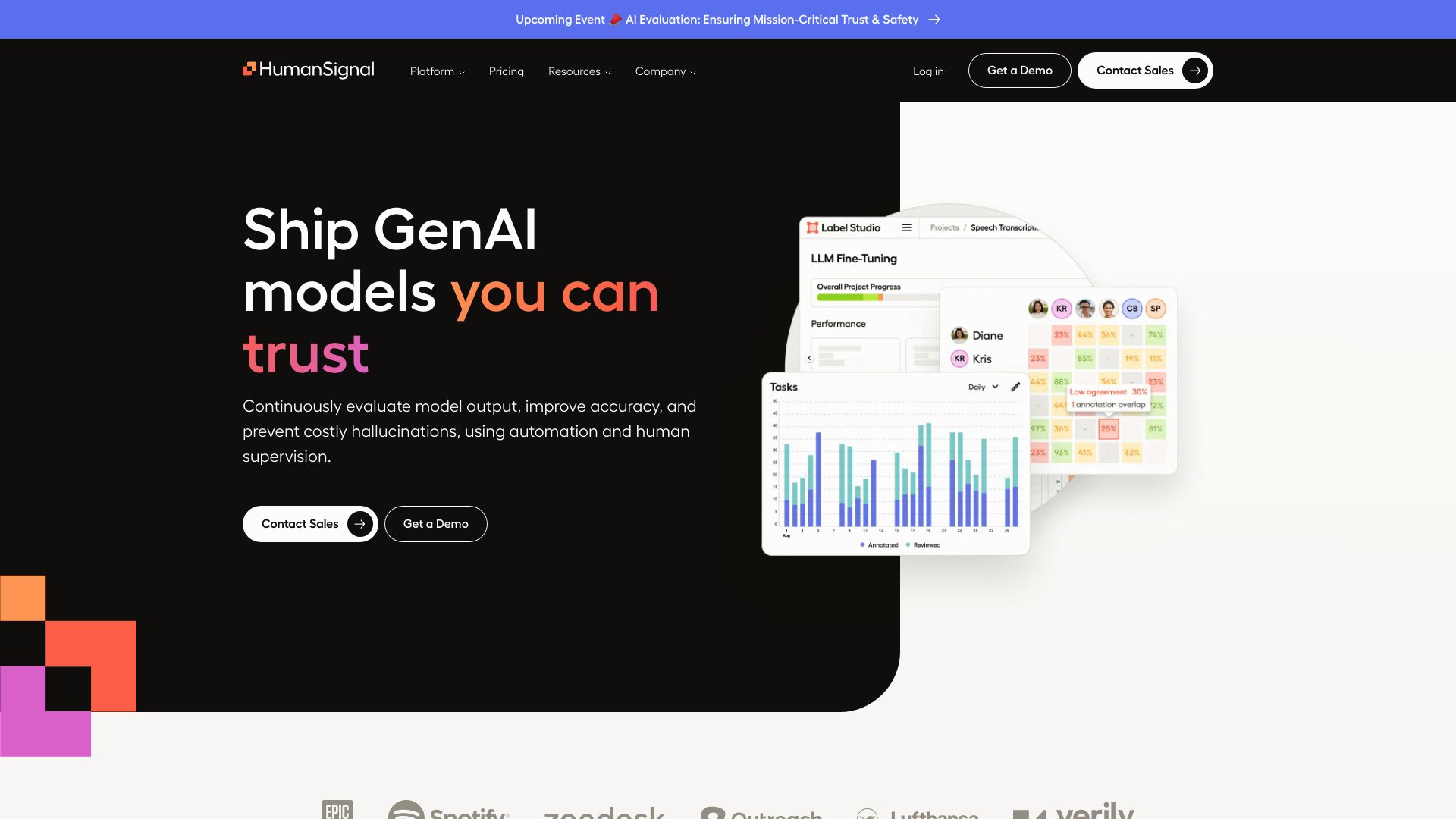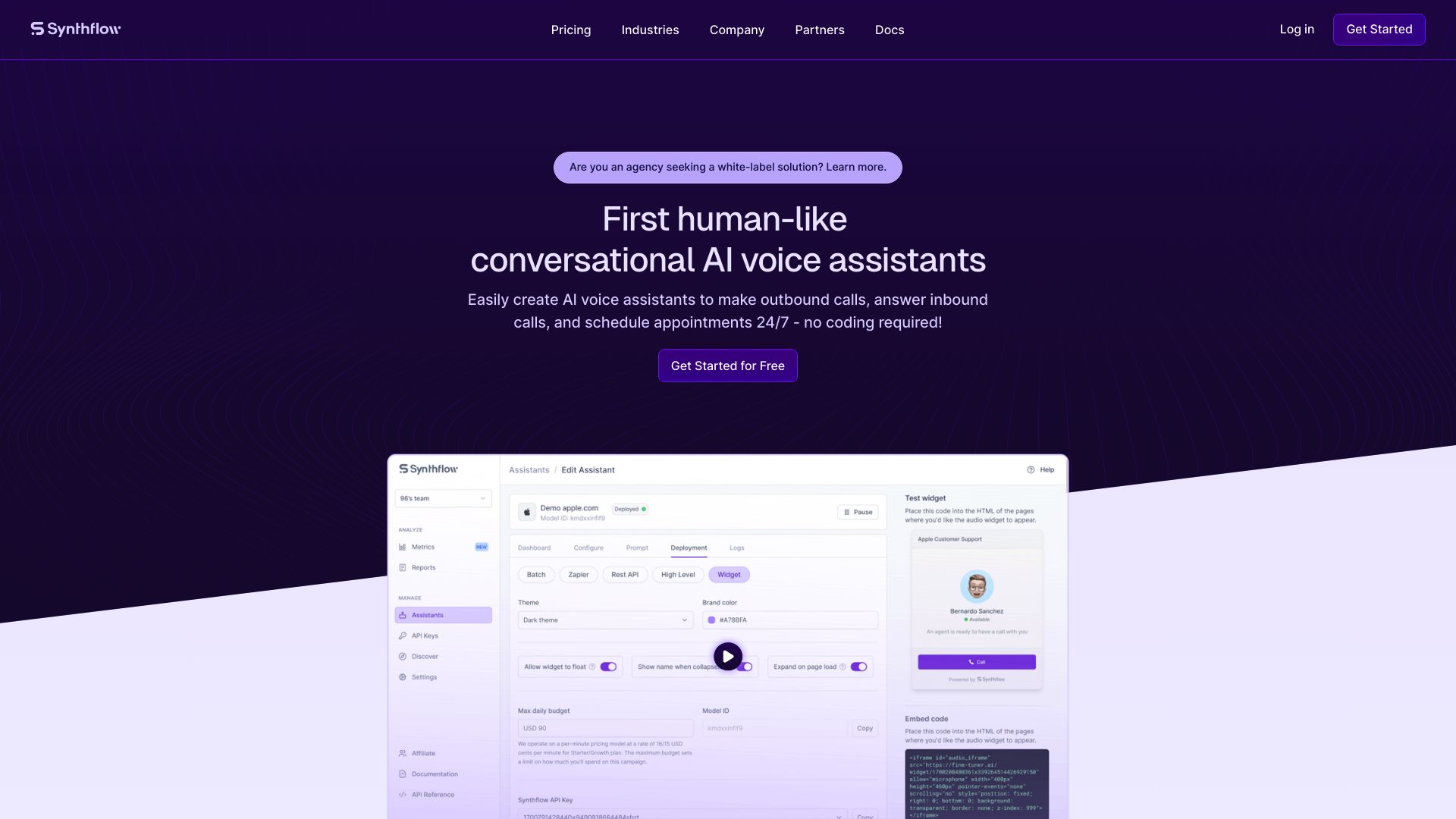Adala vs. Synthflow: AI Agents for Data and Voice
AI agent platforms Adala and Synthflow offer distinct approaches to automating data tasks and customer interactions. Adala’s open-source framework empowers developers to build autonomous data labeling agents, while Synthflow’s no-code platform enables businesses to create AI voice assistants without technical expertise.
This comparison explores their core features, strengths, and limitations to help you determine which solution best fits your organization’s needs. We’ll also introduce SmythOS, a comprehensive AI development platform that combines powerful capabilities with user-friendly design, potentially outperforming both Adala and Synthflow for many use cases.
Adala Overview
Adala revolutionizes data labeling with its open-source framework for building autonomous AI agents. These agents acquire specialized skills like text classification, summarization, and question answering through interactions with data and human feedback. Adala leverages large language models as its core runtime, enabling agents to execute complex tasks efficiently.
Adala revolutionizes data labeling with its open-source framework for building autonomous AI agents … enabling agents to execute complex tasks efficiently.


Adala’s modular architecture encourages community contributions, fostering continuous evolution and improvement. The platform supports both development and production environments, allowing users to create, test, and deploy agents seamlessly. Adala emphasizes reliability through human-in-the-loop processes, enabling agents to refine their skills based on expert input.
Adala emphasizes reliability through human-in-the-loop processes, enabling agents to refine their skills based on expert input.
A key strength of Adala lies in its ability to handle large datasets and process batches of records, making it ideal for enterprises with extensive data labeling needs. The framework includes robust tracking and logging capabilities, facilitating performance monitoring and analytics. While Adala excels in text-based tasks, it currently lacks explicit support for multimodal inputs or visual building tools.
Adala’s focus on autonomous data labeling positions it as a valuable tool for organizations seeking to streamline their data processing workflows. However, users should note that Adala requires some technical expertise to implement effectively, as it does not offer no-code options or visual builders. This approach ensures flexibility and customization but may present a steeper learning curve for non-technical users.
Synthflow Overview
Synthflow AI empowers businesses to create customizable AI voice assistants without coding expertise. Its no-code platform features an intuitive interface, pre-built templates, and step-by-step guidance, making advanced AI technology accessible to users with varied technical backgrounds.
The platform excels in developing AI assistants for customer support, lead generation, appointment scheduling, and issue triaging. Synthflow AI prioritizes data security, offering unlimited secure storage in a dedicated Pinecone environment. Integration capabilities with tools like 11Labs and Twilio expand its functionality across various business processes.
Synthflow AI empowers businesses to create customizable AI voice assistants without coding expertise. Its no-code platform features an intuitive interface… making advanced AI technology accessible to users with varied technical backgrounds.


Synthflow stands out with its batch deployment feature for large-scale communication campaigns and real-time interaction through website widgets. The platform supports both novice users and experienced developers, providing comprehensive documentation and support to maximize its capabilities.
While Synthflow AI offers robust features for creating and managing AI voice assistants, it lacks some advanced capabilities found in other platforms. The absence of a visual builder and limited multimodal support may restrict its applicability in certain complex scenarios. Additionally, the platform doesn’t explicitly mention features like debug mode or extensive problem-solving capabilities, which could be crucial for some users.
Synthflow AI’s vision centers on democratizing AI technology for businesses of all sizes. By providing accessible tools for AI-driven customer engagement, the platform aims to streamline operations and drive growth across various industries. Its focus on user-friendliness and integration with existing business tools positions Synthflow AI as a valuable solution for organizations looking to enhance their customer interactions and operational efficiency through AI technology.
Feature Comparison
Adala vs. Synthflow offer distinct approaches to AI agent development, with notable feature gaps in core components and security. Adala provides an open-source framework for building autonomous data labeling agents, emphasizing modularity and extensibility. Its architecture supports skill development through interactions with data and human feedback. In contrast, Synthflow focuses on creating customizable AI voice assistants without coding expertise, offering a no-code platform with pre-built templates.
In terms of core components, Adala excels in providing a flexible environment for developing specialized AI skills like text classification and summarization. However, it lacks a visual builder and no-code options, which Synthflow prominently features. Synthflow’s intuitive interface and step-by-step guidance make it more accessible to users with varied technical backgrounds, but it may not offer the same level of customization as Adala’s code-based approach.
Security-wise, Synthflow prioritizes data protection with unlimited secure storage in a dedicated Pinecone environment. Adala, while emphasizing reliability and trustworthiness, does not explicitly mention advanced security features like data encryption or OAuth implementation. This gap in security specifications could be a significant consideration for users dealing with sensitive data or requiring robust authentication mechanisms.
| Adala | Synthflow | SmythOS | |
|---|---|---|---|
| CORE FEATURES | |||
| Hosted Agents (Dev, Production) | ❌ | ✅ | ✅ |
| Visual Builder | ❌ | ✅ | ✅ |
| No-Code Options | ❌ | ✅ | ✅ |
| Debug Tools | ❌ | ✅ | ✅ |
| Multimodal | ❌ | ❌ | ✅ |
| Multi-Agent Collaboration | ❌ | ✅ | ✅ |
| Audit Logs for Analytics | ❌ | ✅ | ✅ |
| SECURITY | |||
| Data Encryption | ❌ | ✅ | ✅ |
| OAuth | ❌ | ✅ | ✅ |
| IP Control | ❌ | ❌ | ✅ |
| COMPONENTS | |||
| Huggingface AIs | ❌ | ❌ | ✅ |
| Zapier APIs | ❌ | ✅ | ✅ |
| All other APIs, RPA | ❌ | ✅ | ✅ |
| Classifiers | ✅ | ❌ | ✅ |
| Data Lakes | ❌ | ❌ | ✅ |
| DEPLOYMENT OPTIONS (EMBODIMENTS) | |||
| Deploy as Webhook | ❌ | ✅ | ✅ |
| Staging Domains | ❌ | ❌ | ✅ |
| Production Domains | ❌ | ❌ | ✅ |
| API Authentication (OAuth + Key) | ❌ | ✅ | ✅ |
| Deploy as Site Chat | ❌ | ✅ | ✅ |
| Deploy as Scheduled Agent | ❌ | ✅ | ✅ |
| DATA LAKE SUPPORT | |||
| Sitemap Crawler | ❌ | ✅ | ✅ |
| YouTube Transcript Crawler | ✅ | ✅ | |
| URL Crawler | ❌ | ❌ | ✅ |
| PDF Support | ❌ | ❌ | ✅ |
| Word File Support | ❌ | ❌ | ✅ |
| TXT File Support | ❌ | ❌ | ✅ |
Best Alternative to Adala and Synthflow
SmythOS emerges as the superior alternative to Adala and Synthflow for AI agent development and deployment. Our platform combines powerful features with user-friendly design, making advanced AI capabilities accessible to users of all skill levels. We offer a comprehensive solution that addresses the limitations of both Adala’s open-source framework and Synthflow’s no-code voice assistant platform.
SmythOS emerges as the superior alternative to Adala and Synthflow for AI agent development and deployment. Our platform combines powerful features with user-friendly design…
Our visual builder and no-code options surpass Adala’s code-centric approach, allowing users to create sophisticated AI agents without extensive programming knowledge. Unlike Synthflow’s focus on voice assistants, we provide a versatile platform for developing AI agents across multiple domains and use cases. Our drag-and-drop interface, pre-built templates, and extensive API integrations enable rapid development and deployment of AI solutions for various business needs.
Security and scalability set SmythOS apart from competitors. We implement robust data encryption, OAuth authentication, and IP control features, ensuring your AI agents operate in a secure environment. Our platform supports seamless scaling from development to production, with staging and production domains for testing and live deployment. This enterprise-grade infrastructure accommodates growing demands without compromising performance or security.
SmythOS excels in data handling and integration capabilities. We support a wide range of data sources, including PDFs, Word documents, and web crawlers, expanding the knowledge base for your AI agents. Our hosted vector database and data lake support enable efficient processing of large datasets, empowering your agents with comprehensive information access. These features, combined with our multimodal capabilities and support for various AI models, provide unparalleled flexibility in creating intelligent, context-aware agents for diverse applications.
By choosing SmythOS, you gain access to a cutting-edge AI agent builder that combines ease of use with advanced functionality. Our platform empowers businesses to harness the full potential of AI technology, driving innovation and efficiency across industries. With SmythOS, we’ve eliminated the tradeoffs between powerful features and user-friendly design, offering a complete solution for AI agent development that surpasses both Adala and Synthflow in capabilities and versatility.
Conclusion
Adala and Synthflow offer distinct approaches to AI-powered solutions, each with unique strengths. Adala’s open-source framework excels in building autonomous data labeling agents, leveraging large language models for complex tasks. Its modular architecture and emphasis on human-in-the-loop processes make it a powerful tool for organizations with extensive data labeling needs and technical expertise.
Synthflow AI focuses on creating customizable AI voice assistants without coding, featuring a user-friendly interface and pre-built templates. Its strengths lie in customer support, lead generation, and appointment scheduling applications, making it accessible to users with varied technical backgrounds. However, Synthflow’s limitations in visual building tools and multimodal support may restrict its use in more complex scenarios.
While both platforms offer valuable solutions, SmythOS stands out as the superior choice for businesses seeking a comprehensive AI development and deployment platform. Our drag-and-drop interface, extensive integration ecosystem, and versatile deployment options make AI creation 99% faster and more accessible. SmythOS supports multimodal interactions, problem-solving capabilities, and scalable embodiments like APIs, chatbots, and scheduled agents.
With robust security features, data lake support, and the ability to work with various AI models, SmythOS empowers users to harness the full potential of AI across industries. To experience the power of SmythOS and revolutionize your AI workflows, create a free account today and start building your first AI agent.
Last updated:
Disclaimer: The information presented in this article is for general informational purposes only and is provided as is. While we strive to keep the content up-to-date and accurate, we make no representations or warranties of any kind, express or implied, about the completeness, accuracy, reliability, suitability, or availability of the information contained in this article.
Any reliance you place on such information is strictly at your own risk. We reserve the right to make additions, deletions, or modifications to the contents of this article at any time without prior notice.
In no event will we be liable for any loss or damage including without limitation, indirect or consequential loss or damage, or any loss or damage whatsoever arising from loss of data, profits, or any other loss not specified herein arising out of, or in connection with, the use of this article.
Despite our best efforts, this article may contain oversights, errors, or omissions. If you notice any inaccuracies or have concerns about the content, please report them through our content feedback form. Your input helps us maintain the quality and reliability of our information.
